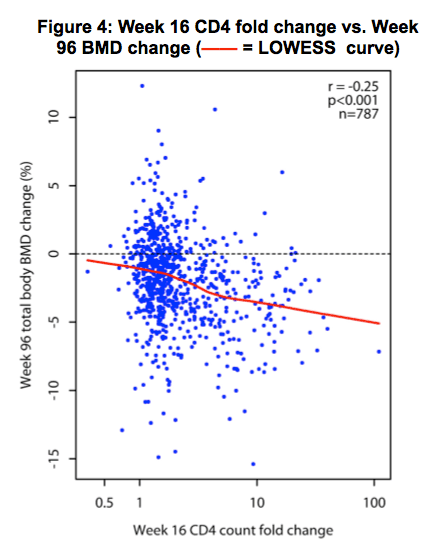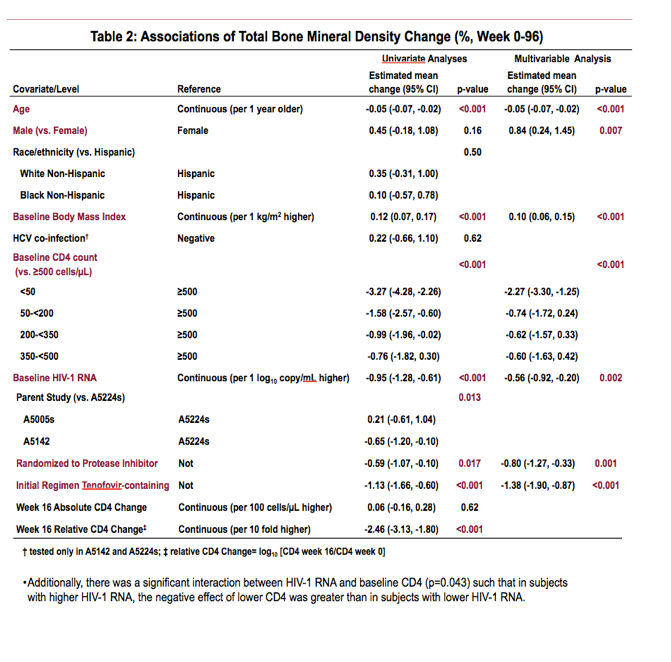 |
 |
 |
| |
Lower Baseline CD4 is Associated with Greater Loss of Bone Mineral Density after ART Initiation
|
| |
| |
Reported by Jules Levin
CROI 2013 March 3-6 Atlanta
Philip Grant*1, Douglas Kitch2, Grace McComsey3, Michael Dube4, Richard Haubrich5, Jeannie Huang5, Sharon Riddler6, Pablo Tebas7, Andrew Zolopa1, and Todd Brown8
1Stanford, Palo Alto, CA; 2Harvard School of Public Health, Boston, MA; 3Case Western, Cleveland, OH; 4USC, L.A., CA; 5UCSD, San Diego, CA; 6University of Pittsburgh, Pittsburgh, PA; 7University of Pennsylvania, Philadelphia, PA; 8Johns Hopkins, Baltimore, MD

BACKGROUND: BMD decreases 2-6% in the first two years after ART initiation. The mechanisms for the loss are unclear, but pre-ART immune status and early immune recovery may contribute.
METHODS: We pooled data from three treatment-naïve ART initiation studies in which serial DXA was performed (ACTG A5005s, A5142, and A5224s). Linear regression was used to evaluate effects of baseline CD4, absolute CD4 change, and relative CD4 change (log10[CD4 week16/CD4 week 0]) on 96-week total BMD change. Multivariable linear regression was used to assess the association between the baseline variables of age, sex, race/ethnicity, body mass index (BMI), hepatitis C, CD4, HIV RNA level, parent study, and assignment to a protease inhibitor (PI) or tenofovir (TDF)-containing regimen, and 16-week CD4 changes on 96-week BMD change. We explored interactions between baseline CD4 and the above baseline covariates on 96-week BMD change.
RESULTS: A total of 796 subjects with 96-week BMD change (mean age 39 years; 83% male) were included. Mean baseline CD4 was 224 cells/uL and 96-week BMD loss (standard deviation) was 2.0% (3.3). A greater relative, but not absolute, 16-week increase in CD4 was significantly associated with greater declines in BMD (p<0.001 and 0.54), but not after controlling for baseline CD4 (p=0.21). In multivariable analysis compared to subjects with baseline CD4≥500 cells/uL, subjects with lower CD4 had greater decrease in BMD at week 96 (p<0.001; Table). In addition to low baseline CD4, older age, female sex, lower BMI, higher HIV RNA, and PI and TDF use were associated with greater BMD declines. There was a significant interaction between HIV RNA and baseline CD4 (p=0.043) such that in subjects with higher HIV RNA, estimated mean differences in BMD decline in lower CD4 groups versus the CD4≥500 group were greater than in subjects with lower HIV RNA.

CONCLUSIONS: Lower pre-treatment CD4 is a strong and independent risk factor for bone loss after ART initiation. ART initiation at higher CD4 may reduce the burden of osteoporosis and fragility fracture.







|
| |
|
 |
 |
|
|